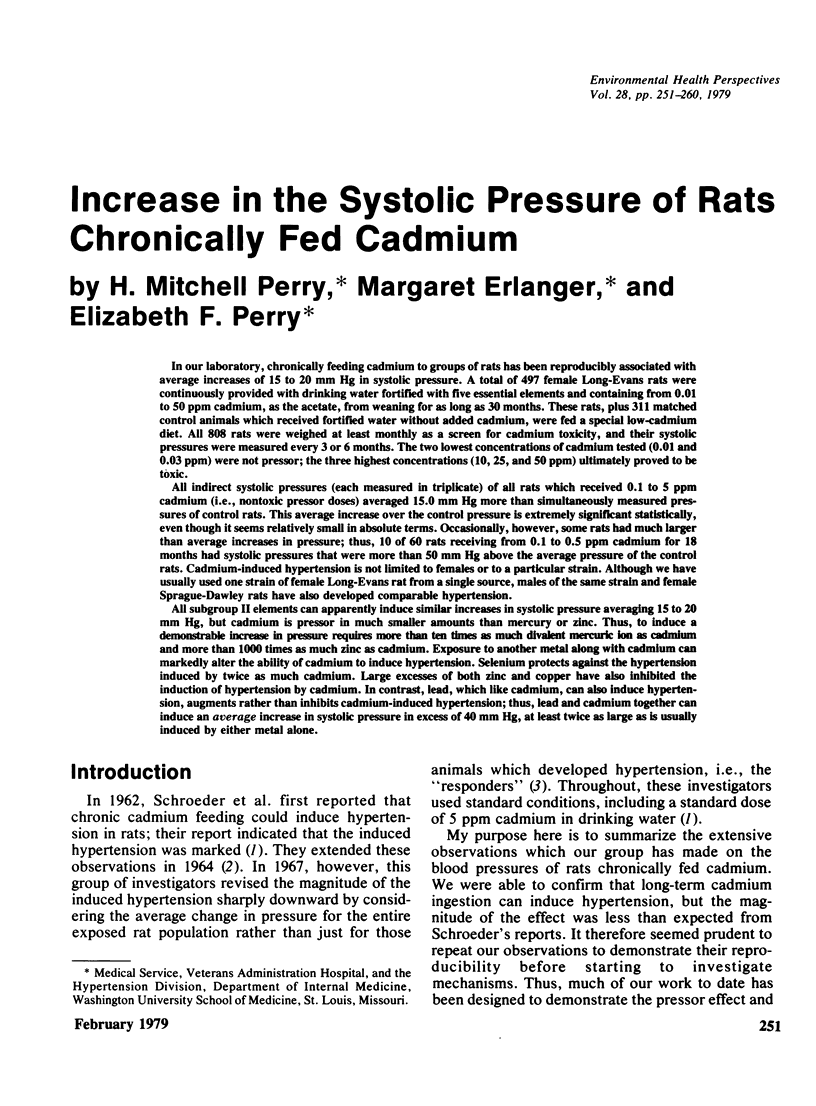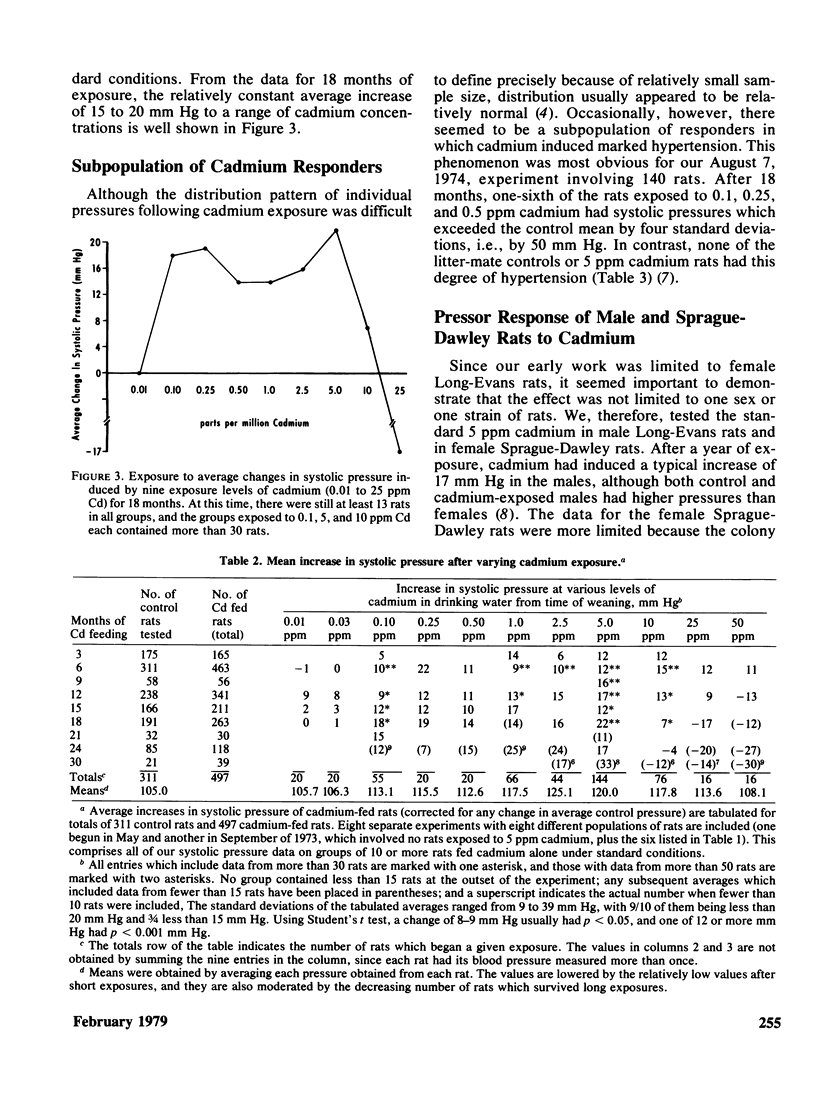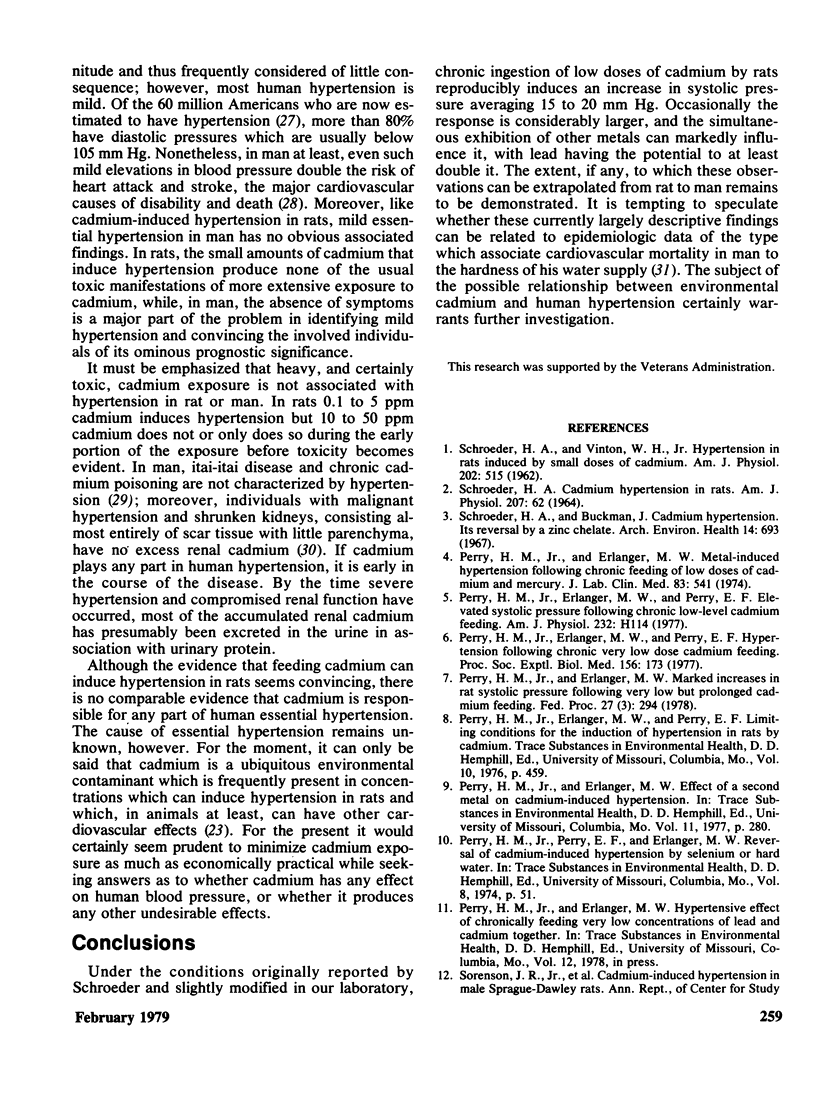Abstract
In our laboratory, chronically feeding cadmium to groups of rats has been reproducibly associated with average increases of 15 to 20 mm Hg in systolic pressure. A total of 497 female Long-Evans rats were continuously provided with drinking water fortified with five essential elements and containing from 0.01 to 50 ppm cadmium, as the acetate, from weaning for as long as 30 months. These rats, plus 311 matched control animals which received fortified water without added cadmium, were fed a special low-cadmium diet. All 808 rats were weighed at least monthly as a screen for cadmium toxicity, and their systolic pressures were measured every 3 or 6 months. The two lowest concentrations of cadmium tested (0.01 and 0.03 ppm) were not pressor; the three highest concentrations (10, 25, and 50 ppm) ultimately proved to be toxic.
All indirect systolic pressures (each measured in triplicate) of all rats which received 0.1 to 5 ppm cadmium (i.e., nontoxic pressor doses) averaged 15.0 mm Hg more than simultaneously measured pressures of control rats. This average increase over the control pressure is extremely significant statistically, even though it seems relatively small in absolute terms. Occasionally, however, some rats had much larger than average increases in pressure; thus, 10 of 60 rats receiving from 0.1 to 0.5 ppm cadmium for 18 months had systolic pressures that were more than 50 mm Hg above the average pressure of the control rats. Cadmium-induced hypertension is not limited to females or to a particular strain. Although we have usually used one strain of female Long-Evans rat from a single source, males of the same strain and female Sprague-Dawley rats have also developed comparable hypertension.
All subgroup II elements can apparently induce similar increases in systolic pressure averaging 15 to 20 mm Hg, but cadmium is pressor in much smaller amounts than mercury or zinc. Thus, to induce a demonstrable increase in pressure requires more than ten times as much divalent mercuric ion as cadmium and more than 1000 times as much zinc as cadmium. Exposure to another metal along with cadmium can markedly alter the ability of cadmium to induce hypertension. Selenium protects against the hypertension induced by twice as much cadmium. Large excesses of both zinc and copper have also inhibited the induction of hypertension by cadmium. In contrast, lead, which like cadmium, can also induce hypertension, augments rather than inhibits cadmium-induced hypertension; thus, lead and cadmium together can induce an average increase in systolic pressure in excess of 40 mm Hg, at least twice as large as is usually induced by either metal alone.
Full text
PDF









Selected References
These references are in PubMed. This may not be the complete list of references from this article.
- Doyle J. J., Bernhoft R. A., Sandstead H. H. The effects of a low level of dietary cadmium on blood pressure, '24Na, '42K, andwater retention in growing rats. J Lab Clin Med. 1975 Jul;86(1):57–63. [PubMed] [Google Scholar]
- Lown B., Wolf M. Approaches to sudden death from coronary heart disease. Circulation. 1971 Jul;44(1):130–142. doi: 10.1161/01.cir.44.1.130. [DOI] [PubMed] [Google Scholar]
- Paul O. Complications of mild hypertension. Ann N Y Acad Sci. 1978 Mar 30;304:59–66. doi: 10.1111/j.1749-6632.1978.tb25568.x. [DOI] [PubMed] [Google Scholar]
- Perry H. M., Jr, Erlanger M. W. Elevated circulating renin activity in rats following doses of cadmium known to induce hypertension. J Lab Clin Med. 1973 Sep;82(3):399–405. [PubMed] [Google Scholar]
- Perry H. M., Jr, Erlanger M. W. Metal-induced hypertension following chronic feeding of low doses of cadmium and mercury. J Lab Clin Med. 1974 Apr;83(4):541–547. [PubMed] [Google Scholar]
- Perry H. M., Jr, Erlanger M., Perry E. F. Elevated systolic pressure following chronic low-level cadmiun feeding. Am J Physiol. 1977 Feb;232(2):H114–H121. doi: 10.1152/ajpheart.1977.232.2.H114. [DOI] [PubMed] [Google Scholar]
- Perry H. M., Jr, Erlanger M., Perry E. F. Hypertension following chronic, very low dose cadmium feeding (39900). Proc Soc Exp Biol Med. 1977 Oct;156(1):173–176. doi: 10.3181/00379727-156-39900. [DOI] [PubMed] [Google Scholar]
- Perry H. M., Jr, Erlanger M., Yunice A., Perry E. F. Mechanisms of the acute hypertensive effect of intra-arterial cadmium and mercury in anesthetized rats. J Lab Clin Med. 1967 Dec;70(6):963–972. [PubMed] [Google Scholar]
- Perry H. M., Jr, Perry E. F., Purifoy J. E. Antinatriuretic effect of intramuscular cadmium in rats. Proc Soc Exp Biol Med. 1971 Apr;136(4):1240–1244. doi: 10.3181/00379727-136-35466. [DOI] [PubMed] [Google Scholar]
- SCHROEDER H. A. CADMIUM HYPERTENSION IN RATS. Am J Physiol. 1964 Jul;207:62–66. doi: 10.1152/ajplegacy.1964.207.1.62. [DOI] [PubMed] [Google Scholar]
- Schroeder H. A., Baker J. T., Hansen N. M., Jr, Size J. G., Wise R. A. Vascular reactivity of rats altered by cadmium and a zinc chelate. Arch Environ Health. 1970 Nov;21(5):609–614. doi: 10.1080/00039896.1970.10667304. [DOI] [PubMed] [Google Scholar]
- Schroeder H. A., Buckman J. Cadmium hypertension. Its reversal in rats by a zinc chelate. Arch Environ Health. 1967 May;14(5):693–697. doi: 10.1080/00039896.1967.10664821. [DOI] [PubMed] [Google Scholar]
- Schroeder H. A. Cadmium, chromium, and cardiovascular disease. Circulation. 1967 Mar;35(3):570–582. doi: 10.1161/01.cir.35.3.570. [DOI] [PubMed] [Google Scholar]


